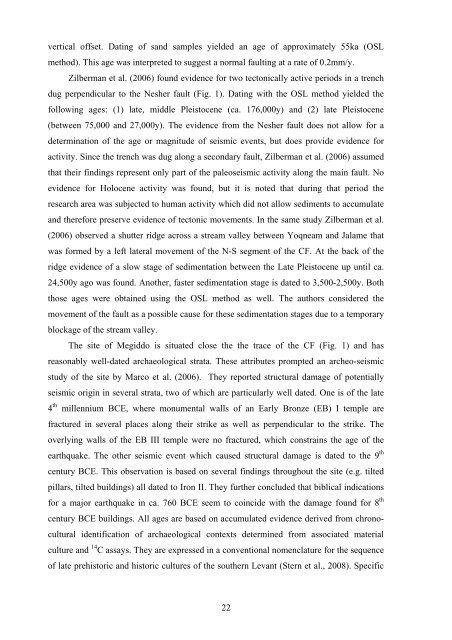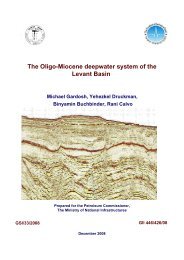tivity on the carmel faul
tivity on the carmel faul
tivity on the carmel faul
Create successful ePaper yourself
Turn your PDF publications into a flip-book with our unique Google optimized e-Paper software.
vertical offset. Dating of sand samples yielded an age of approximately 55ka (OSL<br />
method). This age was interpreted to suggest a normal <strong>faul</strong>ting at a rate of 0.2mm/y.<br />
Zilberman et al. (2006) found evidence for two tect<strong>on</strong>ically active periods in a trench<br />
dug perpendicular to <strong>the</strong> Nesher <strong>faul</strong>t (Fig. 1). Dating with <strong>the</strong> OSL method yielded <strong>the</strong><br />
following ages: (1) late, middle Pleistocene (ca. 176,000y) and (2) late Pleistocene<br />
(between 75,000 and 27,000y). The evidence from <strong>the</strong> Nesher <strong>faul</strong>t does not allow for a<br />
determinati<strong>on</strong> of <strong>the</strong> age or magnitude of seismic events, but does provide evidence for<br />
ac<str<strong>on</strong>g>tivity</str<strong>on</strong>g>. Since <strong>the</strong> trench was dug al<strong>on</strong>g a sec<strong>on</strong>dary <strong>faul</strong>t, Zilberman et al. (2006) assumed<br />
that <strong>the</strong>ir findings represent <strong>on</strong>ly part of <strong>the</strong> paleoseismic ac<str<strong>on</strong>g>tivity</str<strong>on</strong>g> al<strong>on</strong>g <strong>the</strong> main <strong>faul</strong>t. No<br />
evidence for Holocene ac<str<strong>on</strong>g>tivity</str<strong>on</strong>g> was found, but it is noted that during that period <strong>the</strong><br />
research area was subjected to human ac<str<strong>on</strong>g>tivity</str<strong>on</strong>g> which did not allow sediments to accumulate<br />
and <strong>the</strong>refore preserve evidence of tect<strong>on</strong>ic movements. In <strong>the</strong> same study Zilberman et al.<br />
(2006) observed a shutter ridge across a stream valley between Yoqneam and Jalame that<br />
was formed by a left lateral movement of <strong>the</strong> N-S segment of <strong>the</strong> CF. At <strong>the</strong> back of <strong>the</strong><br />
ridge evidence of a slow stage of sedimentati<strong>on</strong> between <strong>the</strong> Late Pleistocene up until ca.<br />
24,500y ago was found. Ano<strong>the</strong>r, faster sedimentati<strong>on</strong> stage is dated to 3,500-2,500y. Both<br />
those ages were obtained using <strong>the</strong> OSL method as well. The authors c<strong>on</strong>sidered <strong>the</strong><br />
movement of <strong>the</strong> <strong>faul</strong>t as a possible cause for <strong>the</strong>se sedimentati<strong>on</strong> stages due to a temporary<br />
blockage of <strong>the</strong> stream valley.<br />
The site of Megiddo is situated close <strong>the</strong> <strong>the</strong> trace of <strong>the</strong> CF (Fig. 1) and has<br />
reas<strong>on</strong>ably well-dated archaeological strata. These attributes prompted an archeo-seismic<br />
study of <strong>the</strong> site by Marco et al. (2006). They reported structural damage of potentially<br />
seismic origin in several strata, two of which are particularly well dated. One is of <strong>the</strong> late<br />
4 th millennium BCE, where m<strong>on</strong>umental walls of an Early Br<strong>on</strong>ze (EB) I temple are<br />
fractured in several places al<strong>on</strong>g <strong>the</strong>ir strike as well as perpendicular to <strong>the</strong> strike. The<br />
overlying walls of <strong>the</strong> EB III temple were no fractured, which c<strong>on</strong>strains <strong>the</strong> age of <strong>the</strong><br />
earthquake. The o<strong>the</strong>r seismic event which caused structural damage is dated to <strong>the</strong> 9 th<br />
century BCE. This observati<strong>on</strong> is based <strong>on</strong> several findings throughout <strong>the</strong> site (e.g. tilted<br />
pillars, tilted buildings) all dated to Ir<strong>on</strong> II. They fur<strong>the</strong>r c<strong>on</strong>cluded that biblical indicati<strong>on</strong>s<br />
for a major earthquake in ca. 760 BCE seem to coincide with <strong>the</strong> damage found for 8 th<br />
century BCE buildings. All ages are based <strong>on</strong> accumulated evidence derived from chr<strong>on</strong>ocultural<br />
identificati<strong>on</strong> of archaeological c<strong>on</strong>texts determined from associated material<br />
culture and 14 C assays. They are expressed in a c<strong>on</strong>venti<strong>on</strong>al nomenclature for <strong>the</strong> sequence<br />
of late prehistoric and historic cultures of <strong>the</strong> sou<strong>the</strong>rn Levant (Stern et al., 2008). Specific<br />
22

















